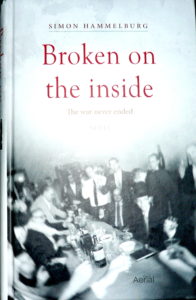Kohn Gallery presents Engender, a group exhibition featuring contemporary artists who are revolutionizing the way we visualize conventional gender as exclusively male or female. Established in 1985, the Kohn Gallery has presented historically significant exhibitions in Los Angeles alongside exciting contemporary artists, creating meaningful contexts to establish links to a greater art historical continuum.
Category Archives: The Arts
Multicultural Art and Poetry
Come Back for Me: Holocaust Novel – by Sharon Hart-Green
 Loss, trauma, memory, and the impenetrable ties of family are the elements that weave together Sharon Hart-Green’s panoramic debut novel Come Back for Me (New Jewish Press). Set in the aftermath of World War II, it is a gripping story about the redemptive power of love and self-understanding.
Loss, trauma, memory, and the impenetrable ties of family are the elements that weave together Sharon Hart-Green’s panoramic debut novel Come Back for Me (New Jewish Press). Set in the aftermath of World War II, it is a gripping story about the redemptive power of love and self-understanding.
Come Back for Me tells the story of two young Jewish characters; one is a Hungarian Holocaust survivor Artur Mandelkorn who is on a desperate quest to find his beloved sister, Manya, after they become separated during the war. Artur’s journey takes him to Israel where he falls in love with Fanny, a young woman who still bears the scars of her own tragic past in Germany.
Continue reading Come Back for Me: Holocaust Novel – by Sharon Hart-Green
Interview with Kim Wayans: Comedian & Advocate – by Deborah Levine
Kim is a key member of the Wayans clan that created TV’s In Living Color. The ten Wayans siblings grew up poor in New York City’s Chelsea neighborhood. Elvira, Kim’s mother, was a homemaker and social worker who took the kids everywhere, no nannies, and no babysitter. Their father was a supermarket manager and the Jehovah’s Witness in the family. With no background in the entertainment business and little money, the Wayans’ success is an unlikely story.
Continue reading Interview with Kim Wayans: Comedian & Advocate – by Deborah Levine
‘Violence Against Black Bodies’ is About More Than Black Deaths – Book Review by Elwood Watson
It wasn’t supposed to be like this, not now at least. America is firmly within the twenty first century, yet we are struggling to deal with the problem that W.E.B. Dubois so aptly identified in 1903 as the problem of the twentieth century. That problem was the color line, which refers to institutional racism, discrimination and segregation. Looking ahead over a century later, it seems little has changed. While that assertion is unfair to a point—after all, we had a black president and legal segregation is prohibited –certainly the dynamics of racism are still as vibrant, conspicuous and ubiquitous in American life as ever—there is a problem throughout U.S. history that never subsides, and, as if to operate in cyclical fashion, sometimes gains momentum.
The Art and Civics of Publisher Ruth Holmberg: Making History — by Deborah Levine
 Long before The New York Times had its first woman Executive Editor, Ruth Holmberg was the Editor of The Chattanooga Times. Holmberg is a member of the family that founded both newspapers and she has shared her compelling life story as friends and admirers gathered to hear her speak. Holmberg is a former director of The Associated Press and of The New York Times Company, a former president of the Chattanooga Area Chamber of Commerce and of the Southern Newspaper Publisher Association and a member of the Board of Directors of the Public Education Network (PEN).
The petite, soft-voiced woman is also a member of one of the nation’s most prominent publishing families.
Long before The New York Times had its first woman Executive Editor, Ruth Holmberg was the Editor of The Chattanooga Times. Holmberg is a member of the family that founded both newspapers and she has shared her compelling life story as friends and admirers gathered to hear her speak. Holmberg is a former director of The Associated Press and of The New York Times Company, a former president of the Chattanooga Area Chamber of Commerce and of the Southern Newspaper Publisher Association and a member of the Board of Directors of the Public Education Network (PEN).
The petite, soft-voiced woman is also a member of one of the nation’s most prominent publishing families.
Editor’s note: Publishing icon and Chattanooga civic leader Ruth Holmberg passed away at age 96. In her honor, here is the ADR interview with Ms. Holmberg several years ago.
Continue reading The Art and Civics of Publisher Ruth Holmberg: Making History — by Deborah Levine
From Passion to Profit – by Mary D. Moore
 Mary Moore’s personal story of entrepreneurship is an inspiration to all aspiring entrepreneurs and business leaders who hope to make a difference for themselves and their communities. Her journey to success is admirable for its creativity and innovativeness. Her path has not been easy or simple. Yet, the difficulties and disappointments along the way have taught her how to navigate the challenges of entrepreneurship. And now, she is teaching us.
Mary Moore’s personal story of entrepreneurship is an inspiration to all aspiring entrepreneurs and business leaders who hope to make a difference for themselves and their communities. Her journey to success is admirable for its creativity and innovativeness. Her path has not been easy or simple. Yet, the difficulties and disappointments along the way have taught her how to navigate the challenges of entrepreneurship. And now, she is teaching us.
Broken on the Inside: The War Never Ended – by Simon Hammelburg
 Broken on the inside – The War Never Ended by Dutch author and journalist Simon Hammelburg is based on 1200 interviews with Holocaust survivors and their children. The book reads like a novel but is based on facts, some of which have never been revealed before, disclosing insights of the psychological aftermath of survivors as well as the post-war generations and the traumas that are passed on for over six generations.
Broken on the inside – The War Never Ended by Dutch author and journalist Simon Hammelburg is based on 1200 interviews with Holocaust survivors and their children. The book reads like a novel but is based on facts, some of which have never been revealed before, disclosing insights of the psychological aftermath of survivors as well as the post-war generations and the traumas that are passed on for over six generations.
Continue reading Broken on the Inside: The War Never Ended – by Simon Hammelburg
Great diversity leaders of letters – By Terry Howard
I’m often asked to suggest some conferences to attend, good books to read and other ways to learn about diversity. Here’s a glimpse of some of it.
“Who are the contemporary thought leaders on diversity, Terry?” queried one. “Someone suggested “Dr. So-and- So’s” book; would you recommend it?” surfaced in a recent e-mail.
Continue reading Great diversity leaders of letters – By Terry Howard
How Pow Wow Leaders Inspired – by Deborah Levine
 When regional Native Americans convene in Chattanooga’s First Tennessee Pavilion, you’ll find me there, too. This year, the gathering seemed larger and more energetic than ever. I come to admire the colorful dress, hear the drum circle, and watch the dancing. The booths full of Native American arts and crafts are irresistible and my drawers are full of jewelry purchased there. I also come for the honor guard, a promenade of Native American veterans, police, firemen, and war mothers.
When regional Native Americans convene in Chattanooga’s First Tennessee Pavilion, you’ll find me there, too. This year, the gathering seemed larger and more energetic than ever. I come to admire the colorful dress, hear the drum circle, and watch the dancing. The booths full of Native American arts and crafts are irresistible and my drawers are full of jewelry purchased there. I also come for the honor guard, a promenade of Native American veterans, police, firemen, and war mothers.
Continue reading How Pow Wow Leaders Inspired – by Deborah Levine
Honoring Native American Art in the Southeast – by Deborah Levine
There is much beauty to celebrate in Native American art, but that it’s a struggle to create given the devastating historical events surrounding Native Americans. The Cherokee Nation had a culture that thrived for almost 1,000 years in the Southeastern United States: in Georgia, Tennessee, North and South Carolina, and parts of Kentucky and Alabama. Life of the traditional Cherokee changed drastically with European expansion and cession of Cherokee lands to the colonies in exchange for trade goods. Migration from the original Cherokee Nation began in the early 1800s as Cherokees wary of white encroachment moved west and settled in other areas of the country’s vast frontier. Their eventual removal by force prompts the question of whether there is any Cherokee cultural presence remaining in the Southeast.
Continue reading Honoring Native American Art in the Southeast – by Deborah Levine
